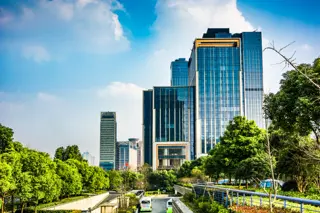Raipur's New Green Building Mandates: A Real Estate Game Changer
 The Raipur Development Authority (RDA) has introduced strict green building rules requiring developers to focus on sustainable practices for all new constructions over 20,000 sq ft. This new policy matches India’s strong push to cut carbon footprints in urban areas while setting a new standard for eco-friendly real estate in growing Indian cities.
The Raipur Development Authority (RDA) has introduced strict green building rules requiring developers to focus on sustainable practices for all new constructions over 20,000 sq ft. This new policy matches India’s strong push to cut carbon footprints in urban areas while setting a new standard for eco-friendly real estate in growing Indian cities.
Important Rules of the New Regulations
1. Required Sustainability Features Throughout Lifespan
- Owners must use energy-efficient HVAC systems (heating, ventilation, air conditioning) and design building envelopes for climate-responsive designs.
- Water conservation measures like rainwater harvesting and greywater recycling systems are mandatory.
- Green landscapes must cover at least 40% of site areas, using native plants to support biodiversity.
2. Matching National Standards Renewable energy and recycled material use will follow frameworks like India’s GRIHA certification for eco-friendly commercial/residential projects. Buildings must meet minimum benchmarks in energy, water, and waste management.
Impact on Developers and Projects
| Aspect | Before New Rules | After New Rules |
|---|---|---|
| Construction Costs | Using conventional materials | Higher initial costs |
| Long-Term Savings | Limited energy efficiency | 30-50% energy savings |
| Compliance | Optional green practices | Mandatory certifications |
Emerging Challenges
- Small developers might find it hard to pay for energy-efficient technologies.
- Supply-chain disruptions could happen due to increased demand for eco-friendly materials.
- Enforcement mechanisms are untested, raising questions about consistent implementation.
Why This Matters for Raipur’s Growth
- Urbanization Pressure: Unlike tier-1 cities, Raipur has rapid population growth without established green infrastructure. These rules address future livability concerns.
- Investor Appeal: Buildings meeting GRIHA standards often get higher rental prices, making Raipur a sustainable investment hub and attract investors.
- Policy Harmonization: The move matches central initiatives to reduce urban carbon footprints while considering Chhattisgarh’s unique environmental challenges.
Future of Real Estate: Raipur’s Sustainability Roadmap
The rules signal a shift towards integrated urban planning. Despite the immediate challenges, the policy lays the groundwork for:
- Smart community designs focusing on green spaces and renewable energy.
- Public-private partnerships to fund green infrastructure.
- Training programs for architects and contractors in sustainable building practices.
For buyers and tenants, this promises better indoor air quality, lower utility bills, and property values aligned with global sustainability trends. As Raipur’s building stock changes, these rules could become a blueprint for smaller Indian cities balancing development with environmental stewardship.